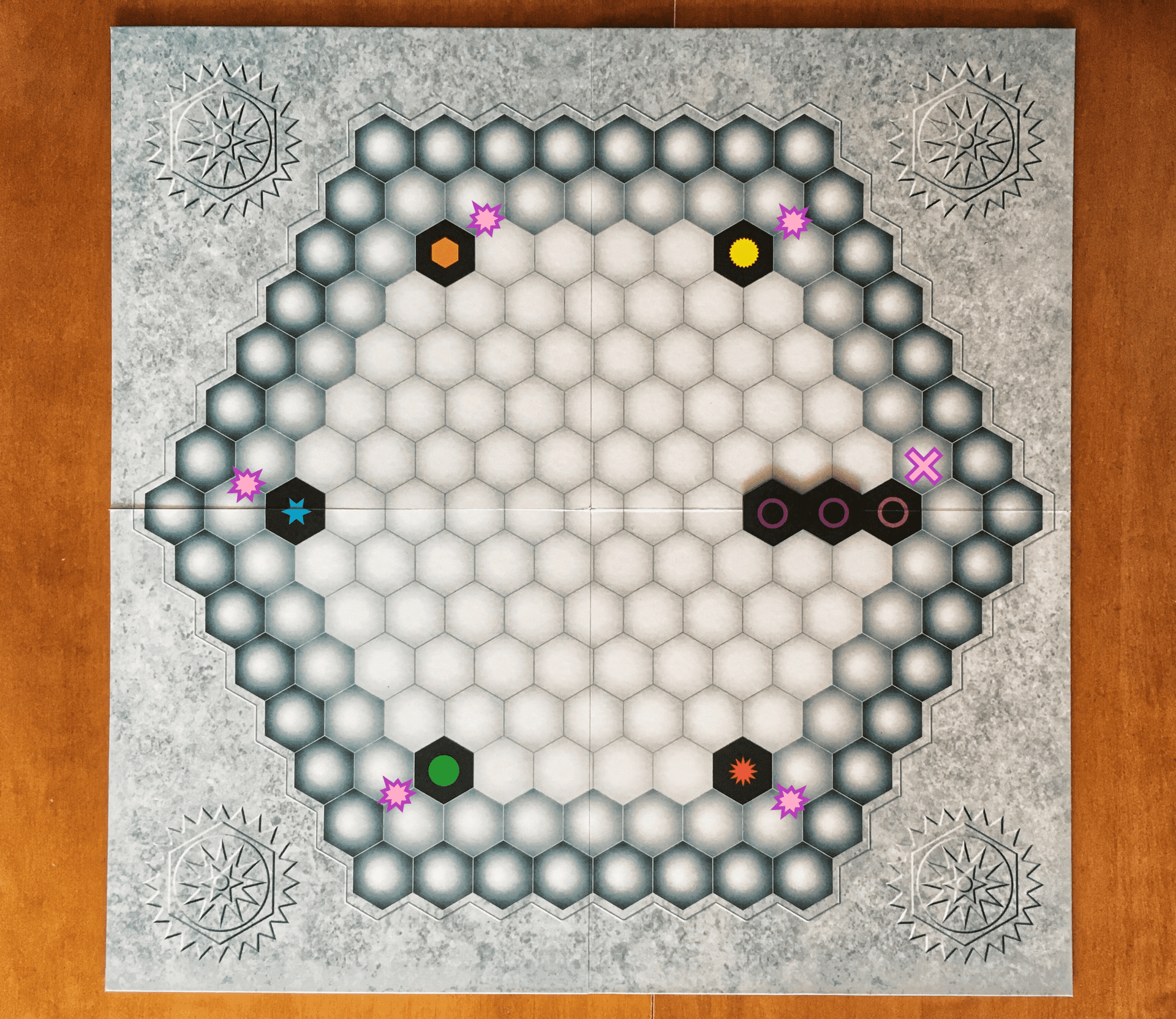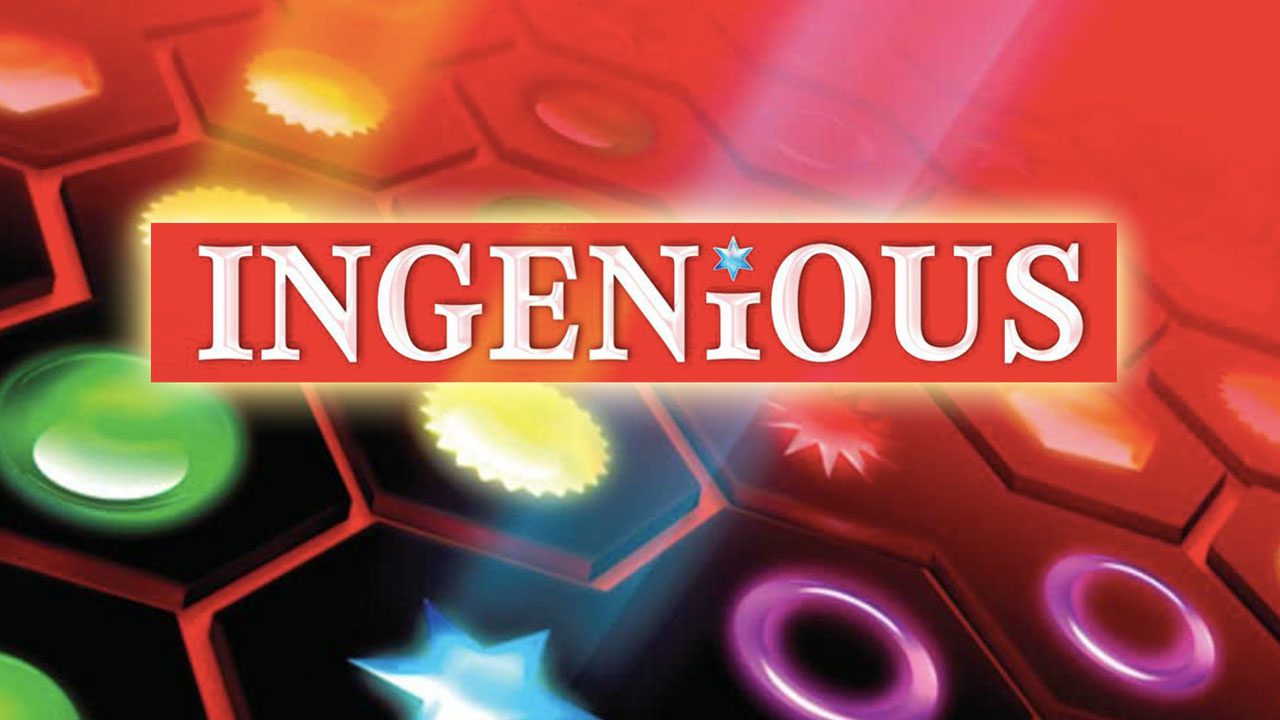Ingenious is an abstract tile placement game designed by the prolific Reiner Knizia that was first published in 2004 and has, for the most part, remained in print since then*. In true Knizia fashion, Ingenious is an easy game to learn, but a difficult one to master.
*You might know the game Ingenious by another name, Axio. There is a whole bunch of legal trademark stuff that happened in recent years which I’m not going to get into in this review as my copy of the game came from KOSMOS.
Let’s take a look at how Ingenious is played.

Ingenious Gameplay
To begin, players start a game of Ingenious with six randomly drawn tiles on their rack (think Scrabble). On your turn, you’ll play one of these tiles to an empty space on the board, possibly score some points, and draw a new tile from the bag. It’s really as simple as that. What makes Ingenious an extra clever game is how tiles are scored.
But first, let’s discuss placing a tile on the board. On your first turn, you must place one of your tiles (from your rack) adjacent to one of the six symbols printed on the board — and you must choose a different symbol from the other players. Your subsequent turns offer much more freedom; you may place your tile anywhere on an empty space of the board.

Next, you score the tile you placed. To do this, imagine there is a sunburst of lines radiating from each symbol on your tile.

Then count the number of uninterrupted symbols — no empty spaces or other symbols — in each line that match the symbol on your tile and move your score peg forward as many spaces on your score board.

There are two things to remember when scoring: both symbols on your tile are scored independently in this way (even if they are the same symbol) and you never count the symbols on the tile you just placed.
What’s stopping each player from creating their own big cluster of like symbols? Well, technically nothing…other than that you wouldn’t have a very good final score. This is because, in a classic Knizia move, your final score is the position of your lowest symbol’s peg on your score board. So go ahead and make one giant constellation of stars (blue symbols) and see how well you score — and good luck trying to keep the other players from taking advantage of it.
Finally, to finish your turn, draw a tile from the bag to refresh your rack to six tiles.
Swapping Tiles
It goes without saying — but I am anyway — that a game involving drawing tiles from a bag features a lot of randomness and luck. How crummy would it be to never draw tiles with your lowest symbol? Dr. Knizia to the rescue!
Once per turn, if you don’t have any tiles on your rack with the symbol(s) of your lowest score peg then you may swap your tiles, which must be done before you refresh your rack. To make a swap, show your tiles to the other players — to prove you aren’t a big cheater — put the tiles on your rack aside, draw six new tiles, and then add your old tiles to the bag.
Bonus Placement
Your score board maxes out at 18 and when a score peg reaches this final space, you’ll get a bonus tile placement — but first you must call out “Ingenious!” (You are free to choose the tone of voice you use; my first choice is Vizzini.) This bonus tile placement (and subsequent scoring) happens before you draw tiles to refresh so make sure to plan accordingly.
Game End
A game of Ingenious comes to a close when no more tiles can be placed on the board. Then determine your final score, indicated by the position of your lowest score peg. The player who has the highest lowest score wins.
Final Thoughts
What a wonderful work of ingenuity this game is! Reiner Knizia is no stranger to abstract games: from his heavier Euro games like Tigris & Euphrates to his smaller, lighter card games like L.L.A.M.A, Knizia knows how to design a good abstract. I’m not sure if we can credit this gift to his math brain, but somehow Knizia always manages to create abstract games with very simple rules and mechanisms and yet they manage to still have so much depth. Not surprisingly one of his more popular family weight abstracts, Ingenious, is no exception.
My favourite part of Ingenious is having to balance scoring all six symbols (colours) and I love the thinking that goes into placing a tile on the board — and given that the board is initially very open, there is a lot of thinking.
If I place this double orange tile, I’m creating a good spot for another player to score many points, but I really need to bump up my orange. Maybe I can set myself up and place the tile in such a way that it doesn’t entice other players and hope my plan works out? But there’s also that perfect opening on the board to score red points. I don’t really need more red points, but can I really let someone else take advantage of it?
And the thinking goes on and on. Whenever I’ve played Ingenious, I find the table is very quiet for most of the game, undoubtedly because everyone playing is having the same internal dialogue and thought processes as I am.

Ingenious is so good and such a perfect family weight game that it was nominated for the Spiel des Jahres in 2004 — and, in another world, I would argue that it deserved to win if it hadn’t been up against Ticket to Ride (a game that I am incredibly biased towards). Nonetheless, both of these games could fit nicely on any gamer’s shelf…as long as you kept them on opposite ends of your Kallax.
Ingenious is yet another abstract hit from designer Reiner Knizia. If you don’t believe me, try the game out for yourself.












Oh my! This is my favorite game from Dr. Knizia (or perhaps #2, right behind Blue Moon). However you slice it, it is a game I love to see getting love at my table and online with reviews like this one. Well done!